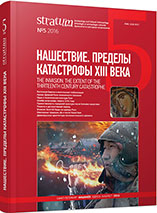Русские и ордынцы: культурное восприятие и неприятие
The Russians and the Horde Peoples: Cultural Acceptance and Rejection
Author(s): Natalia V. ZhilinaSubject(s): History, Archaeology, Cultural history, Middle Ages, 13th to 14th Centuries
Published by: Издательский дом Stratum, Университет «Высшая антропологическая школа»
Keywords: Rus’; the Golden Horde; 13th—17th centuries; culture; acceptance; rejection; costume; attire of adornments; applied arts
Summary/Abstract: Written, figurative and substantial sources are compared to elucidate the processes of acceptance and rejection of cultural achievements in the period of the Golden Horde domination over Rus’. Rejection due to the reaction to the cruelties of the conquest, humiliation and destruction of Russian culture by the Mongols, as well as to the difference of traditions in the sphere of religion, art and lifestyles. Difference between Russian and Mongolian costumes prevented the natural process of mutual influence. Pieces of imperial costume granted by the Mongols had only superficial and temporary result. Costume would not change much due to usage of similar details from another one, if they were independent from the overall construction.The Russian and Mongolian culture in the second half of the 13th—15th centuries experienced opposite processes. The Golden Horde intensively enriched by the achievements of many peoples and countries. The nature of this acceptance, however, was largely unproductive, it did not lead to true synthesis and therefore was not lasting. After an involuntary pause In Rus’, the craft and applied art revived based on own pre-Mongol samples and self-dependent realization of new artistic trends famous upon more common samples of decorative art from different countries.
Journal: Stratum plus. Археология и культурная антропология
- Issue Year: 2016
- Issue No: 5
- Page Range: 223-250
- Page Count: 28
- Language: Russian
- Content File-PDF

